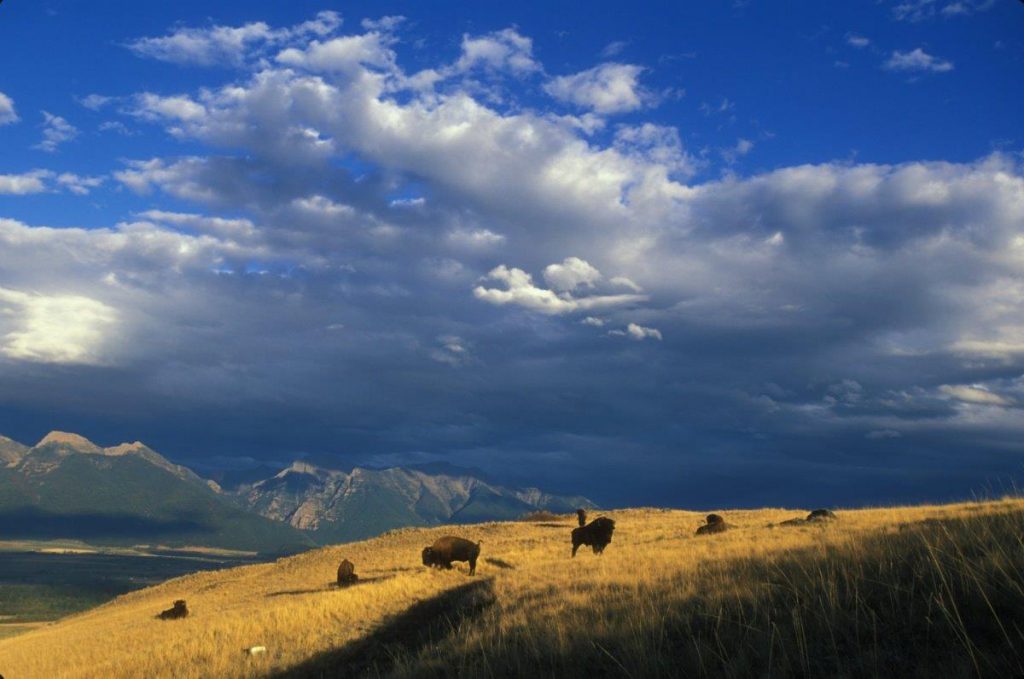
Long in the works, the 250 to 300 buffalo that live on this refuge as well as the National Bison Range itself have been turned over to the Confederated Salish and Kootenai Tribes as of Dec. 27, 2021, when President Donald Trump signed it into law. These tribes have strong historical, geographic and cultural ties to the land and the bison. Credit Ryan Hagerty, US FWS.
The Act further states that this restored land shall be a part of the Flathead Indian Reservation, administered as tribal trust land and managed by the Tribes. This includes all bison on the range, as well as all buildings and structures located on the land.
The law establishes a 2-year transition period, during which the Secretary will cooperate with the Tribes in transition activities regarding the management of land, bison, and other resources. This includes providing to the Tribes, as determined appropriate by the Secretary, funds, personal property, equipment, or other resources.
The range has been transferred to the Confederated Salish and Kootenai Tribes (CSKT). Red Sleep Mountain is the historic name of the mountain which contains the National Bison Range and its one-way tourist auto route over the Red Sleep Mountain.
The local Salish, Pend d’Oreille and Kootenai people convey how important the buffalo is to their traditional way of life. Today, the Tribe keeps their culture vibrant and alive with an annual River Honoring, Pow Wows, Native language schools, active cultural committees, and a tribal museum at the People’s Center.
“The CSKT have strong and deep historical, geographic and cultural ties to the land and the bison, and their environmental professionals have been leaders in natural resources and wildlife management for many decades,” Interior Assistant Secretary Tara Katuk Sweeney wrote in her statement. “Interior is pleased to continue its partnership and work with them on the restoration of the (National Bison Range) to federal trust ownership for the Tribes.”
Tribal Chairwoman Shelly Fyant said the transfer returned care of the bison to the people who had made it a mainstay of their culture, the Missoulian reported.
It was included as part of the Montana Water Rights Protection Act, co-sponsored by all three members of Montana’s congressional delegation: Senators Steve Daines (R) and JonTester (D) and Rep (now Gov.) Greg Gianforte (R).
That act also settled a long-standing treaty negotiation that gave the CSKT rights to major water resources inside the Flathead Indian Reservation in return for releasing claims on more than 10,000 water rights outside its boundaries.
“The restoration of this land is a great historic event and we worked hard to reach this point,” Fyant said.
“This comes after a century of being separated from the buffalo and the Bison Range, and after a quarter-century-long effort to co-manage the refuge with the FWS (U.S. Fish and Wildlife Service).”
CSKT spokesman Robert McDonald said the public would see little change on the 18,800-acre wildlife refuge covering Red Sleep Mountain south of Pablo.
The Tribal Council agreed to continue following the conservation plan developed by FWS that controls how the refuge is managed for wildlife and the public.
“The Fish and Wildlife Service is still in place,” McDonald said on Friday. “The Tribal Council is in regular contact with them, and we’re working on an agreement for how things will progress and operate in the future.
“There are a lot of questions about staffing, positions, what should be added or remain—things like maintenance crews, biologists, people in the gift shop and cultural interpretation. We’re in the early process of hashing out how it’s going to go.”
McDonald said the mission of the refuge to be a publicly accessible landscape focused on preserving wild bison would not change.
On Thursday, CSKT officials announced they were replacing federal regulations governing hunting, fishing and recreation on the refuge with an essentially identical set of rules authorized by the Tribes.
The replaced regulations include rules governing user fees to enter the refuge, prohibition of fireworks, weapons or explosives except under authorized circumstances, prohibition of hunting or taking of resources from the refuge except as authorized, and use of motorized vehicles.
McDonald said the exceptions would apply to actions previously allowed by FWS. Boy Scout troops, for instance, have been allowed to gather shed elk antlers and biologists have conducted studies involving capturing or occasionally killing specimen wildlife. Those exceptions would continue under tribal management, he said.
The original herd of bison released in 1909 was purchased with private money raised by the American Bison Society and then donated to the Refuge.
Today, 250-300 bison live on this refuge. To keep track of herd health, the Refuge conducts an annual Bison capture. And to ensure the herd is in balance with their habitat, surplus bison are donated and/or sold live, according to the US Fish and Wildlife.
(ORDER NO. 3390 from the U.S. Fish and Wildlife Service and Bureau of Land Management to the Bureau of lndian Affairs and the Confederated Salish and Kootenai Tribes.)

Francie M Berg
Author of the Buffalo Tales &Trails blog



